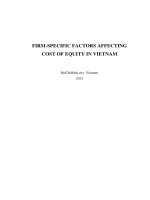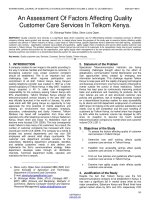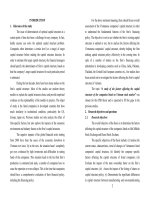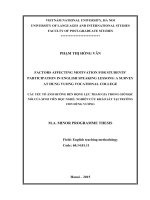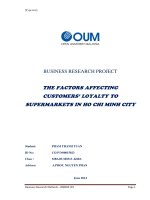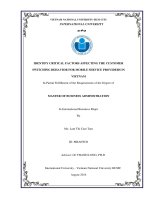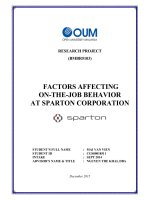Factors affecting online impulse buying behavior in fashion products in vietnam
Bạn đang xem bản rút gọn của tài liệu. Xem và tải ngay bản đầy đủ của tài liệu tại đây (1.48 MB, 95 trang )
UNIVERSITY OF ECONOMICS HO CHI MINH CITY
International School of Business
------------------------------
TRUONG KIM NGAN
FACTORS AFFECTING ONLINE IMPULSE
BUYING BEHAVIOR IN FASHION PRODUCTS
IN VIETNAM
MASTER OF BUSINESS (Honours)
Ho Chi Minh – 2015
UNIVERSITY OF ECONOMICS HO CHI MINH CITY
International School of Business
------------------------------
TRUONG KIM NGAN
FACTORS AFFECTING ONLINE IMPULSE
BUYING BEHAVIOR IN FASHION PRODUCTS
IN VIETNAM
ID:22130044
MASTER OF BUSINESS (Honours)
SUPERVISOR: Dr. LE NHAT HANH
Ho Chi Minh – 2015
ACKNOWLEDGEMENTS
The completion of this thesis is a remarkable achieve in my life. It has been
several months and required a great effort for the research. I would like to express my
gratitude to all ISB staffs that supported necessary materials and helped summit my
papers. I also wish to express my deeply thank you for the support, patience and
encouragement from my family, my colleagues and my classmates helped me to
completing this thesis.
Especially, I would like to give my special thanks to Doctor Le Nhat Hanh for
supporting and guiding me with this research.
STATEMENT OF AUTHENTICATION
(Candidate Certificate)
I certify that the work in the thesis entitled “Factors affecting online impulse buying
behavior in fashion products in Vietnam” is the result of my own research and has not been
submitted for a higher degree to any university or institution other than International School
of Business (ISB).
I also certify that the thesis has been written by me. Any help and assistance that I
have received in my thesis have been appropriately acknowledged.
Ho Chi Minh City, 21 December 2015
Truong Kim Ngan
TABLE OF CONTENTS
CHAPTER I: INTRODUCTION ......................................................................................................... 1
1.1.Research background ..................................................................................................................... 1
1.2. Research objectives ....................................................................................................................... 2
1.3. Research methodology and scope ................................................................................................. 3
1.4. Significance of the study ............................................................................................................... 4
1.5. Structure of the study .................................................................................................................... 4
CHAPTER II: LITERATURE REVIEW ............................................................................................ 5
2.1. Impulse Buying ............................................................................................................................. 5
2.1.1. Definition ........................................................................................................................................ 5
2.1.2. Classification of impulse buying ..................................................................................................... 7
2.1.3. Impulse buying model ..................................................................................................................... 8
2.2. Online Impulse Buying .............................................................................................................. 10
2.3. Factors affecting online impulse buying................................................................................................... 12
2.3.1. Impulsiveness ................................................................................................................................ 12
2.3.2. Electronic word of mouth .............................................................................................................. 12
2.3.3. Hedonic shopping motivation ........................................................................................................ 14
2.3.4. Convenience orientation ................................................................................................................ 15
2.3.5. Sales promotion ............................................................................................................................. 16
2.3.6. Website quality .............................................................................................................................. 16
2.4. Hypothesis & Research Model ................................................................................................................. 18
2.5. Consumer’s characteristics ....................................................................................................................... 19
CHAPTER III: RESEARCH METHODOLOGY ............................................................................. 23
3.1. Research Process ......................................................................................................................... 23
3.2. Qualitative research..................................................................................................................... 24
3.3. Quantitative research................................................................................................................... 27
3.3.1. Questionnaire................................................................................................................................. 27
3.3.2. Data collection method .................................................................................................................. 27
3.3.3. Sample size .................................................................................................................................... 28
3.3.4. Data analysis method..................................................................................................................... 28
CHAPTER IV: ANALYSIS RESULTS ............................................................................................ 32
4.1. Sample description ...................................................................................................................... 32
4.2. Reliable analysis ......................................................................................................................... 33
4.3. Exploratory factor analysis ......................................................................................................... 35
4.3.1 Exploratory Factor Analysis for independent variables ................................................................. 36
4.3.2 Exploratory Factor Analysis for online impulse buying behavior .................................................. 41
4.4. Testing correlations between all constructs................................................................................. 43
4.5. Testing the research model and the hypotheses ............................................................................. 43
4.6.1. Influence of gender ........................................................................................................................ 47
4.6.2. Influence of age ............................................................................................................................. 48
4.6.3. Influence of education ................................................................................................................... 49
4.6.4. Influence of income ....................................................................................................................... 50
4.7. Discussions.................................................................................................................................. 51
CHAPTER V: CONCLUSIONS AND IMPLICATIONS................................................................. 53
5.1. Conclusions ................................................................................................................................. 53
5.2. Implications ................................................................................................................................. 54
5.3. Limitations and implications for future research ........................................................................ 57
REFERENCES................................................................................................................................... 58
REFERENCE
APPENDIX
LIST OF ABBREVIATIONS
ANOVA
Analysis Of Variance
EFA
Exploratory Factor Analysis
KMO
Kaiser-Meyer-Olkin measure
Sig
Observed significance level
SPSS
Statistical Package for the social sciences
VECITA
Vietnam E-commerce and Information Technology Agency
VIF
Variance inflation factor
LIST OF TABLES
Table 3.1: Measurement scale …………………………………………..…… 26
Table 4.1: Demographic Characteristics of the Study………………………… 32
Table 4.2: Cronbach's Alpha measures of variables in the study………...…… 34
Table 4.3: KMO and Bartlett's Test (EFA for independent variables the first 36
time)……………………………………...................................................……
Table 4.4: Total Variance Explained (EFA for independent variables the first 37
time)…………………………………….……….
Table 4.5: Rotated Component Matrix…………………………………...…… 38
Table 4.6: KMO and Bartlett's Test (EFA for independent variables the second 39
time)……………………………………… …………………………………..
Table 4.7: Total Variance Explained (EFA for independent variables the 39
second time)…………………………………………………………………
Table 4.8: Rotated Component Matrix…………………………………...…… 41
Table 4.9: KMO and Bartlett's Test (EFA for online impulse buying 42
behavior)……………………………………… …………………………..
Table 4.10: Total Variance Explained (EFA for online impulse buying 42
behavior)………………… …………………………………………………
Table 4.11: Component Matrixa (EFA for online impulse buying 42
behavior)………………………………………….. ………………………..
Table 4.12: Correlations………………………………………………….…
43
Table 4.13a: ANOVA…………………………………………………….
44
Table 4.13b: Model Summary………………………………………………
44
Table 4.13c: Coefficients…………………………………………………
47
Table 4.14a: Independent Samples Test (gender) …………………….………. 48
Table 4.14b: Group Statistics (gender)………………………………………
48
Table 4.15a: Test of Homogeneity of Variances (age)………………………
48
Table 4.15b: ANOVA (age)…………………………………………………
49
Table 4.15c: Report (age)…………………………………………………
49
Table 4.16a: Test of Homogeneity of Variances (education)……………
49
Table 4.16b: ANOVA (education)………………………… ……………
50
Table 4.17a: Test of Homogeneity of Variances (income)…………....………. 50
Table 4.17b: ANOVA (income) ……………………………………………
50
Table 4.17c: Report (income) ………………………………………………… 51
LIST OF FIGURES
Figure 2.1: Churchill and Peter’s model of Impuse buying process ....09
Figure 2.2: Research Model……………………….…….……………19
Figure 3.1: Research Process…………………….….…….…………..23
Figure 4.1: Histogram…………………………..…..…………………43
Figure 4.2: Scatter Diagrams………………………..…….…………..46
ABSTRACT
This study will broaden my understanding about online impulse buying in general as
well as in fashion products category. The research also enhances the main factors affecting
impulse buying and propose implications to enhance customer’s impulse buying behavior.
The researcher validate factors affecting to online impulsive buying by analyzing data
collected via a web-based questionnaire survey from 352 online customers. The results
indicate that all factors such as: impulsiveness, electronics word of mouth, hedonic shopping
motivation, convenience orientation, sales promotion, website quality play significant role in
online impulse buying beavior. In addition, it provides that these main factors not only has a
direct impact on online impulsive buying, but also an indirect influence through age, gender,
income… .This group of factors will not be examimed as hypothesis. The study takes and
simple testing the effect of this group factor impact to online impulsive buying behavior.
Besides, this study also presents about the method and research design used in the current
study to explore these relationships. The procedure to analyze the data collected will be
mentioned this research. Accordingly, the process includes test of cronbach‘s alpha
coefficient of reliability, EFA and regression by SPSS software.
It implies that the online retailer have to pay attention to improve their advantages
compettiton such as: sales promotion-the most important factor affecting online impulse
buying behavior, some actions can express an impulsiveness customer characteristics. Others
factors e-WOM, website quality also play an important role. Therefore, online retailers who
want to encourage their customers to buy impulsively should pay great attention to these
dimensions. The research findings also engage with some limitations in the strength of
measurement scale, the sampling method as well as the fitness between the research model
and data. It results in the valuable directions for further researches in future
CHAPTER I: INTRODUCTION
In the first chapter, the background of the chosen research subject will be presented, along
with problem background and the purpose of this thesis. Finally, the research question will
be addressed with the research objectives that will be clarified clearly in later parts.
1.1. Research background
In the past, consumers must go to the store and buy commodities directly. It takes much
times and brings the inconvenience to consumers, especially who are far away from the store.
Nowadays, as the Internet has been developing, more buyers are enjoying online shopping
because the Internet services are as a convenient way to shop. Consumers can buy goods,
even services, online, where makes more options for them. Online shopping offers many
advantages, such as facility, rapidity, a 24-hour opening and unrestricted geography.
In recent years, e-commerce development in Vietnam maintained a strong pace forward
due to the booming of Internet. In parallel with massive internet application trend, ecommerce has been getting into various branches of business and daily life, becoming a
significant tool for enterprises and residents. The rapid expansion of the country’s ecommerce sector, thanks to the fast growth rate of Internet users, has forced The Vietnam ECommerce and Information Technology Agency (VECITA) to revise its 2015 forecast for the
sector from $1.3 billion to over $4 billion in revenue (Vietnam e-commerce report 2014).
Given the current Internet population of more than 30 million, economic development
will grant Internet access to even more people in the next two years. With 40-45 percent of
its population forecasted to use the Internet by 2015, VECITA foretold that every Vietnamese
person will spend at least $150 on e-commerce purchases per year. A survey of 781 online
shoppers in 2014 conducted by tuoitrenews.vn indicated that 61 percent of them purchased
items via e-commerce websites, 51 percent through group-buying websites, 45 percent by
means of social forums, 19 percent by way of e-marketplace websites, and six percent via
mobile applications. The most popular online product categories were fashion, shoes and
1
cosmetics, making up 62 percent. Second ranked technology products (35 percent), followed
by household products (32 percent), and flight tickets (25 percent).
The growth of electronic commerce has led to a number of research studies aimed at
understanding how traditional offline consumer behavior manifests in an e-commerce
domain. In the offline contexts, impulse buying can account for between 30 and 50 percent
of all retail sales (Hausman, 2000). Given the prominence of impulse buying in offline retail
environments, impulse buying has been identified as a phenomenon that is also prevalent in
online contexts (Li, H., C. Kuo, and M. G. Russell., 1999). Understanding of impulse buying
is further confounded by the prevalence of online retailing, an easily available mode for
making impulse purchases. Online retailing eliminates the constraints of time and space that
often face shoppers. And recent study found that Internet shoppers are more impulsive than
in-store shoppers. However, consumer behavior on the Internet is not well understood.
Furthermore, most of conceptualizations do not account for impulse purchases online.
Despite the fast growth of e-commerce, the number of studies were conducted about online
shopping Vietnam is very little. In addition, there is no research studying about online impulse
buying. Therefore, it is necessary to conduct a study to broaden the concept of impulse
purchasing and examine impulsive purchasing online in Vietnam e-commerce online market.
As mentioned above, research on impulse buying has been based on various conceptual
definition and mostly focused on in-store retailing. In this research, researcher attempt to
broaden the concept of impulse buying behavior and explore the factors affect impulse buying
on the Internet. With the booming of online retailing, it would seem appropriate to expand the
concept of impulse buying to accurately capture online impulse purchasing behavior.
Therefore, this research will try to figure out the main factors affecting impulse buying and
propose implications to enhance customer’s impulse buying behavior.
1.2. Research objectives
Unlike traditional shopping transactions, online customers do not need sales associates
and cashiers to complete a transaction. In traditional shopping setting, impulse buying might
be triggered by the persuasiveness of a salesperson or sales promotion, the layout or the
2
atmosphere of store, or enticing product arrangements. This is widely understood via many
studies. However, little is known about the identity and nature of factors that may trigger or
inhibit impulse buying during online transactions. Questions pertaining to which factors
significant effects on impulse buying in online setting have not been conclusively answered.
According to above discussion, this study is formulated to obtain following objectives:
(1) To understand clearly about impulsive buying and online impulsive buying
(2) To identify and test various factors such as impulsiveness, electronic word of
mouth, hedonic shopping motivation, convenience orientation, sales promotion,
website quality that may influence online impulse buying in fashion product in
Vietnam.
(3) How do these factors affect to the impulsive buying behavior when people go
shopping online, especially fashion product market.
1.3. Research methodology and scope
The research is conducted on online consumers in Ho Chi Minh City, the biggest city
in Vietnam. Particularly, data is collected from indepth interview from two types of person
one was from young officers of company and another was from student of University in Ho
Chi Minh. The researcher then validate factors affecting to online impulsive buying by
analyzing data collected via a web-based questionnaire survey from 400 online customers.
Content of questionnaire focus on fashion product, the most popular online product in
Vietnamese e-commerce market.
The researcher will use Microsoft Excel and SPSS to handle the collected data and to
perform the research. Then, using SPSS to test the scale reliability (Cronbach’s Alpha), Factor
analysis to determine which of a large set of items were answered most similarly by the
respondents, using Multiple Regression to check the relationship between independent
variables and dependent variables.
3
1.4. Significance of the study
This study will broaden understanding about online impulse buying in general as well
as in fashion products category. Furthermore, online retailers would have a tool that could be
employed to examine current and potential patrons, thereby providing guidance for store
design and marketing communications strategy.
1.5. Structure of the study
This study is organized into five chapters:
Chapter I: Introduction
This chapter presents the research background of the study, research objectives,
research scopes and methodology, the significance of the study, and the research structure.
Chapter II: Literature review and hypotheses
In this chapter, the researcher presents the fundamental theories and definition of each
mentioned concept and theoretical modeling with the proposed hypotheses. In this chapter,
the conceptual model of the study is also presented.
Chapter III: Research Methodology
This chapter mentions about the research design, research methodology and illustrate
the process of conducting the research.
Chapter IV: Analysis Results
For this chapter, the researcher summaries the characteristics of collected samples and
presents the result of the research after analyzing collected data. Based on that result, the
researcher draws the conclusions for the research hypotheses proposed in Chapter 2.
Chapter V: Conclusions and implications
This chapter performs the main results of the research, the contribution of the study in
management theory and practice as well as the limitations of the study for future research
direction.
4
CHAPTER II: LITERATURE REVIEW
In this chapter, some literatures are reviewed concerning the impulse buying and online
impulse buying. This research will continue by presenting some popular model related to
impulse buying. Finally, based on literature and model presented, the research model of
impulse buying in fashion in Vietnam will be presented.
2.1. Impulse Buying
2.1.1. Definition
In the traditional decision-making model, the consumer carefully searches for
information on the product, weights the pros and cons, and eventually makes an informed
decision. This process is elaborate and therefore not applied for all decisions. It is not a correct
portrayal for many buying decisions. Some decisions are made under low involvement
conditions. Many of these decisions are a learned response to environmental factors and
specific stimuli. Actions like these are called the impulse buying behavior. Consumer engage
in impulse buying when they feel the need to buy something immediately without concerning
the consequences. Here, the decision is driven by emotions than by rational thinking.
According to many researchers, impulse buying account for a substantial percentage of the
product turnover across a broad range of product. One study suggest that impulsive buyer
account for 1% to 8% of the population, while others claim that 90% of all consumer make
impulse buying. Fashion and related products, such as accessories and shoes, are one of the
top categories to be bought on impulse (Nguyen Thi Tuyet Mai et al. 2003).
The importance of impulse buying in the marketing literature was first identified over
seventy years ago with the research of Clover (1950). And a futher of researchers have made
important contributions to our understanding of impulse purchasing .According to Stern
(1962), unplanned buying refers to purchases that were not planned in advance, and includes
impulse buying. Stern (1962) classified impulse buying into four types: pure, reminder,
suggestion and planned. Stern’s concept is quite significant, because even today most research
studies use his concept of impulse purchase as a starting point. Over time, researchers began
5
to look at consumer characteristics parallel with product characteristics or stimuli as it was
agreed that impulse purchasing is not confined to any particular product or product category.
Then Rook (1987) suggests impulse buying occurs: “when a consumer experiences a sudden,
often persistent urge to buy something immediately. The impulse to buy is hedonically
complex and may stimulate emotional conflict. Also, impulse buying is prone to occur with
diminished regard for its consequences”. This definition has acquired much wider acceptance
than the other previously discussed definitions. However, many have viewed impulse buying
negatively, perhaps due to the lack of perceived behavioral control that is associated with
impulsivity. However, Piron (1991) argues Rook’s definition is too narrow since it implies
that emotional and cognitive reactions must accompany the purchase, because whether or not
customer experiences emotional and cognitive reactions may depend on the economic,
personality, and cultural factors on behalf of the customer and characteristics and price on
behalf of the product. Piron (1991) defined that impulse buying as “a purchase that is
unplanned, the result of an exposure to a stimulus, and decided on the spot”. After 8 years,
Beatty and Ferrell (1998) provided a more extensive definition in that impulse buying is
considered as sudden and immediate purchase with no pre-shopping intentions either to buy
the specific product category or to fulfill a specific buying task. The behavior occurs after
experiencing an urge to buy and it tends to be spontaneous and without a lot of reflection. It
does not include the purchase of a simple reminder item, which is an item that is simply outof-stock at home. Similar to Rook’s definition this definition does not consider the role of
stimuli in the impulse purchase decision. While early impulse purchase research focused on
the product as stimuli, it is likely that advertisements, articles and word of mouth can act as
stimuli. Futhermore, Wells, Parboteeah, and Valacich (2011) revealed that impulse buying
depends on individual characteristics and environmental characteristics. Individual
characteristics represent the traits that remain relatively stable across situations. Environment
characteristics have also been found to influence impulse buying in that an individual may
experience the urge to buy impulsively when he or she is stimulated by certain circumstantial
factors during a shopping interaction. Following that, Muruganantham & Bhakat (2013)
suggested four set of factors influence impulsive buying include: (1) External stimuli, (2)
6
Internal Stimuli, (3) Situational and Product Related Factors, (4) Demographics and SocioCultural Factors. External stimuli refer to marketing cues or stimuli that are placed and
controlled by the marketer in an attempt to lure consumers into purchase behavior. External
Stimuli are related to the shopping and the marketing environment. Internal Stimuli are related
to the different personality related factors which characterises an individual rather than the
shopping environment or stimuli. Internal factors of impulse buying denote the individual’s
internal cues and characteristics that make customers engage in impulse buying. Situational
predictors of impulse buying include the retail location, time of shopping, seasons and
shopping habits. The research found that the characteristics of consumers and their
demographics influence the impulse purchasing. Local market conditions and various cultural
forces could also impact the way consumer; go for impulse purchasing. Impulse buyers are
less likely to consider the consequences of buying on impulse and less likely to thoroughly
evaluate their purchase decisions than a typical informed shopper (Rook 1987). They are more
willing to accept spontaneous buying ideas and are more focused on the immediate
gratification of purchasing the product. Impulse buyers are often drawn to a mysterious
attraction of the product which motivates the buyer to purchase the item (Rook 1987).
The studies mentioned above contributed greatly to our understanding of impulse buying.
Although there are certain controversies related cause impulse buying, most of the research
has come up with the following general points:
First, impulse buying is an unplanned decision to buy a product or service, made just
before a purchase.
Second, consumers are affected by both internal and external factors of impulse
buying. Impulse buying is a result of a purchaser’s immediate reaction to external
stimuli and will not the same due to consumer’s characteristics.
2.1.2. Classification of impulse buying
Stern (1962) classified impulse buying into four types: pure, reminder, suggestion and
planned. Consistent with the preceding definition, a pure impulse purchase occurs when an
individual makes an unplanned purchase after exposure to a stimulus. This type of impulse
7
purchase is characterized by a total lack of planning before the purchase occurs, and
represents a novelty purchase that breaks a normal buying pattern. In an online context, a
customer without an a priori shopping goal, and deciding to purchase a book on tiki.vn would
be considered a pure impulse purchase. Secondly, a reminder impulse purchase occurs when
an individual makes a purchase only after being prompted by seeing the product or some other
relevant cue. The individual did not plan to make a purchase until he or she remembered a
previous experience with or a need for the product when exposed to it. For instance, a
reminder impulse purchase would be if an individual purchases a perfume after seeing it on
the website and realizing that he or she is running out of that product.In contrast to a reminder
impulse purchase, a suggestive impulse purchase occurs when an individual visualizes a need
for a product after seeing it for the first time (i.e., the individual had neither prior knowledge
of nor desire for the product). For instance, an unplanned purchase of a new product made at
www.amazon.com based on the recommendations of the website would be considered a
suggestive impulse purchase. Finally, a planned impulse purchase is when an individual does
not plan a purchase, but searches for or takes advantage of promotions. The individual goes
into a shopping environment with a shopping list, but has the intention of making purchases
based on coupons or promotions. For instance, such a purchase would result if an individual
visited www.nike.com on Black Friday in search of good deals. In this situation, an individual
enters a shopping environment with little to no knowledge of certain products and no explicit
intention to buy them, but may very well purchase them based on the terms of the deal (low
price, free accessories, etc.). The common thread across these different types of impulse
purchases is the unplanned nature of the behavior, whereby the individual buys the product
impulsively after being exposed to. This paragraph aims to enhance the knowledges of
impulse buying base on Stern research.
2.1.3. Impulse buying model
The researcher will review some famous model involves impulse buying to help us
have a clear picture of factors affecting impulse buying.
2.1.3.1. Churchill and Peter (1998)
8
According to Churchill and Peter (1998), impulse buying behavior is affected by both internal
and external factors. Churchill and Peter’s model also describe the impulse buying process by
omitting several steps, such as need recognition, information search, and alternative
evaluation. The impulse buying process starts with product awareness. Impulse buyers begin
browsing without having an intention to purchase a certain item or visiting a certain store. As
consumers browse, they are exposed to the stimuli, which triggers customers’ urge to buy on
impulse. When impulse buyers feel the desire to buy, they make a purchase decision without
searching for information or evaluating alternatives. Then, consumers may experience
positive or negative consequences by the post-purchase evaluation after the purchase on
impulse. In this process, consumers are influenced by internal (mood/need/desire, hedonic
pleasure, cognitive/affective evaluation) and external factors (visual merchandising, window
display, in-store form display, floor merchandising, promotional signage) that trigger their
impulse purchase behavior. These factors provide information regarding new products,
fashion trends or coordination tips.
Figure 2.1: Churchill and Peter’s model of Impuse buying process
Source: Churchill and Peter (1998)
2.1.3.2. Impulse buying model of urban customers in Vietnam
9
Nguyen Thi Tuyet Mai et al. (2003) conducted an exploratory study that included both
qualitative and quantitative methods to provide a general understanding of urban Vietnamese
consumers’ impulse buying behaviors. Results show that individualism, age, and income are
significantly related to impulse buying behaviors of Vietnamese consumers. In addition,
personal-use products are the most common impulse purchase items, despite the collectivist
nature of consumers in Vietnam. The authors’ findings suggest that, at least with respect to
impulse buying and despite cultural differences, consumers from transitional economies such
as Vietnam may share some common tendencies and behaviors with consumers in advanced
economies.
2.2. Online Impulse Buying
Most of researchs in online impulse buying was conduct in 2000s when the internet
and e-commerce is booming. But the number of research in online impulse buying is very
limited because online buying is a new field with lots of differences compared to traditional
buying. Preceding research on online impulse buying give us the following points: Donthu
and Garcia (1999) found online shoppers to be more impulsive than non-online shoppers. This
result of this research was confimed by later research of LaRose (2001) and Koski (2004).
LaRose (2001) indentified features of a website like product recommendations,
suggested items, price point categories, notice of sales, etc. That would encourage unregulated
buying (which includes impulse buying). Costa and Laran (2003) have modeled quantitatively
the experiences and consequences of internet impulse buying, suggesting that online
environment affects the level of impulsiveness, in-store browsing and the occurrence of
impulse purchases, as well as a relationship between impulse purchases and positive
emotions. Besides, Koski (2004) identified five features of online websites that encourage
impulse buying. One, shopping online provides anonymity; consumers can shop impulsively
without embarrassment. Two, the internet provides easy access; consumers can make a
purchase 24/7. Third, the internet provides a greater variety of goods. Fourth, direct marketing
and personalized promotions lead consumers to impulse buying. Fifth, consumers can use
credit cards online that encourages impulse purchases. Likewise in a more recent study on
10
impulse buying online, Rhee (2006) found that online impulse buyers showed significantly
higher involvement with apparel and a more positive evaluation of the website attributes in
terms of website design, product presentation, promotion and product search/policy
information. Zhang et al. (2006) in their study about the online impulse purchase suggest that
both consumer’s inherent trait (gender) and environment characteristic (subjective norms)
have positive impact on impulse buying. Depends on previous studies, Dawson and Kim
(2009) in their research about cues on apparel websites that trigger impulse purchases has
found two categories of external impulse buying cues present on apparel websites that entice
people to impulsively buy. Such cues include various sales promotions, gift with purchase,
free shipping, contests or sweepstakes, easy return policies, or idea cues including new styles,
featured items, top picks, and gift ideas to Malee a few. The findings of the study suggest that
online shoppers may value different types of external cues on a web site more than others.
Promotional offers and purchase ideas were desired the most. However, some researchers
considered orther internal factors. As mentioned above, Wells et al. (2011) suggested that
impulse buying depends on individual characteristics and environmental characteristics. The
study found that individuals who frequently engage in impulse purchases often share common
personality traits and characteristics. Individual characteristics include age, hedonic shopping
motivation, self-discrepancy and impulsiveness. Environment factors have also been found to
influence impulse buying in that an individual may experience the urge to buy impulsively
when he or she is stimulated by certain circumstantial factors during a shopping interaction.
In addition, Chaudhuri (2015) proved the impact of hedonic shopping motivation and
demographic characteristics (age, income and gender) on the customers in the impulse buying
behavior.
The preceding reviews suggested two set of factors affecting impulse buying include:
consumer’s
characteristics
(age,
income,
gender,
hedonic
shopping
motivation,
impulsiveness) and environment’s characteristics (website, promotion, features related to
online buying). However, most of preceding research only investigate one or two factors that
affecting impulse buying. There is no comprehensive study on this issue. Another point is that
no study have been conduct in Vietnam market. Therefore, it is necessary to evaluate and
11
select appropriate factors that affecting online impulse buying in Vietnam. In the next part,
researcher will propose the study’s hypothesis and build the conceptual model based on
available literature and studies.
2.3. Factors affecting online impulse buying
2.3.1. Impulsiveness
Impulsiveness or consumer’s impulse buying tendency has been defined as “both the
tendencies to experience spontaneous and sudden urges to make on-the-spot purchases and to
act on these felt urges with little deliberation or evaluation of consequence” (Beatty and
Ferrell, 1998). Another definition from study of Rook and Fisher (1995), impulse buying
tendency or impulsiveness was defined as “a consumer’s tendency to buy spontaneously,
unreflectively, immediately, and kinetically”. Impulsiveness has received considerable
attention from researchers in both traditional and online shopping contexts. Wells et al. (2001)
found that impulsiveness will act as a precursor variable of online impulse buying behavior.
Another study of Zhang et al. (2006) found that impulsiveness has also been found to
positively influence the intention to shop online. Wood (1998) believes that the core definition
of impulse is weakness of will. These kinds of consumers make decisions using unplanned,
careless thinking, often followed by affection or emotional status. The final decisions are
usually against optimal judgment. An individual who rated higher on the impulsiveness scale
have been found to be more likely to experience urges to buy impulsively and to act on these
urges (Dholakia, 2000). These kinds of consumers are weak-willed (Wood). Compared to low
impulsivity consumers, high impulsivity consumers easily connect external information to
internal emotion, incurring impulse buying. Therefore, this study assumes that high
impulsivity consumers will have more online impulse buying behavior than will low
impulsivity consumers. Based on the above arguments, researcher propose the following
hypothesis:
H1: Impulsiveness has positive impact on online impulse buying
2.3.2. Electronic word of mouth
12
After Arndt (1967) clearly pointed out that word of mouth is an important variable influencing
consumers’ decision-making and behavior, word of mouth really caused the attention and indepth research of scholars in the field of marketing. With the development of Internet, wordof-mouth spread to network space, forming online word of mouth, online word of mouth is
also known as electronic word of mouth (eWOM). The power of WOM to influence
consumers’ decision-making processes has long been known to researchers and practitioners;
it has recently become even more important with the advance of the internet. Product review
websites, retailers’ websites, brands’ websites, personal blogs, message boards and social
networking sites are all examples of the types of eWOM.
In traditional shopping environment, the impulsive buying behavior is generally
regarded as a behavior caused by environmental stimuli, personal traits, time, budget and so
on. But there are a lot of difference between the network retail background and traditional
retail background. In the context of online buying, consumers can't touch and try products,
but they can make up the defects through the commodity display, buyers’ use experience, and
the product recommendation system. As the auxiliary decision-making reason increasing,
consumers will have more courage to make a buying decision. Chatterjee (2001) first
proposed that online reviews made possible impact on consumers shopping from a marketing
perspective. Chatterjee thinks that with a high transparency of network information,
consumers can research any relevant product information based on their require, and then
make their buying decisions, which takes more advantage than traditional word of mouth
whether in the accessibility, scope, source and time. And he believes that online comments
will affect the receiver's cognition, beliefs, attitudes and actual decisions. Moreover, LaRose
(2001), as one of the earliest researchers of the online impulse buying, pointed out that product
comments, suggestions and promotion can promote the non-binding network purchase.
QinWu (2009) confirmed that online reviews are an important dimension affecting online
impulse buying behavior, and he also confirmed that the form, the date and the content of the
online comments will significantly impact the online impulse buying. Ya-ping Chang (2012)
suggested that the number of degree of online reviews may stimulate consumers online
impulsive buying when they read positive comments. Recently, Y. Huang et al. (2013) found
13
that Electronic Word-of-Mouth tends to increase consumers’ merchandise awareness and has
significant effect on consumer behavior. So, based on the above arguments, researcher
propose the following hypothesis:
H2: Electronics word of mouth has positive impact on online impulse buying
2.3.3. Hedonic shopping motivation
Hedonic shopping motivation is influence by an individual’s hedonic consumption
needs. Hedonic shopping motivation was defined as a need to satisfy an individual subjective
fun, and pleasure when shopping. According to Arnold and Reynolds (2003), hedonic
motivation is categorized to six categories Maleely adventure shopping, social shopping,
gratification shopping, idea shopping, role shopping, and value shopping. According to
Cinjarević and Petric (2011), adventure shopping, gratification shopping, idea shopping, and
value shopping has the most effect on impulse buying behaviour on consumers. The findings
indicated that consumers engaged in impulse buying behaviour because they see it as a
stimulation to feel excited and self-fulfilled, to feel better and to pampered oneself, to keep
up with the latest trends, technological innovations, and fashions in the market, and to get the
best deals in the market. Other than hedonic motivation, experts also mentioned that utilitarian
motivation is also one of the reasons customers involve in shopping. While hedonic
motivation explains more about customers’ feelings, fun and pleasure fulfilments when
shopping for goods and services, utilitarian motivation explains more about customers’
purchasing decisions that is deemed to be useful, wise, rational, and foolish when shopping
for goods and services. Customers who are influenced by utilitarian motivation usually
purchase goods on a regular basis such as food, clothing, toiletries, and many other necessity
goods, whereas customers who are influenced by hedonic motivation purchase goods on less
than a regular basis such as luxury goods, and other functional goods.
As both hedonic and utilitarian motivations are both involve in customers’ decision
making, however, in this research, we would be only focusing on hedonic motivation because
utilitarian motivation has not been an area of focus for impulse buying in past researchers
(Cinjarevic, Tatic, and Petric, 2011; Kim and Eastin, 2011). Hedonic motivation is most
14
